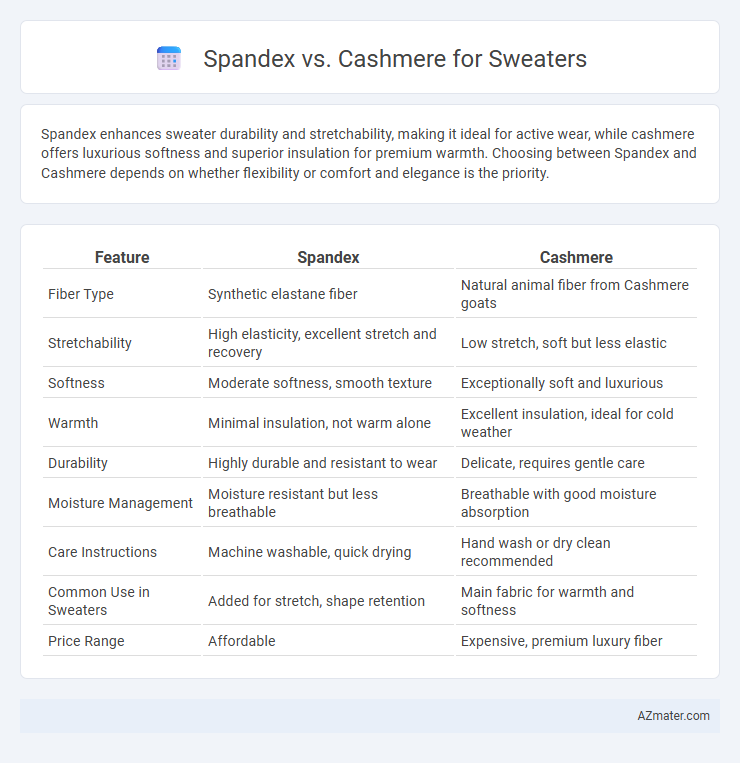Spandex enhances sweater durability and stretchability, making it ideal for active wear, while cashmere offers luxurious softness and superior insulation for premium warmth. Choosing between Spandex and Cashmere depends on whether flexibility or comfort and elegance is the priority.
Table of Comparison
| Feature | Spandex | Cashmere |
|---|---|---|
| Fiber Type | Synthetic elastane fiber | Natural animal fiber from Cashmere goats |
| Stretchability | High elasticity, excellent stretch and recovery | Low stretch, soft but less elastic |
| Softness | Moderate softness, smooth texture | Exceptionally soft and luxurious |
| Warmth | Minimal insulation, not warm alone | Excellent insulation, ideal for cold weather |
| Durability | Highly durable and resistant to wear | Delicate, requires gentle care |
| Moisture Management | Moisture resistant but less breathable | Breathable with good moisture absorption |
| Care Instructions | Machine washable, quick drying | Hand wash or dry clean recommended |
| Common Use in Sweaters | Added for stretch, shape retention | Main fabric for warmth and softness |
| Price Range | Affordable | Expensive, premium luxury fiber |
Introduction to Spandex and Cashmere Sweaters
Spandex sweaters offer exceptional stretch and durability, making them ideal for active wear and form-fitting styles. Cashmere sweaters provide unparalleled softness and warmth due to their luxurious fibers sourced from cashmere goats. Choosing between spandex and cashmere depends on the desired combination of comfort, flexibility, and elegance in sweater fabric.
Origin and Material Composition
Spandex is a synthetic fiber derived from polyurethane, known for its exceptional elasticity and durability, commonly blended with other fabrics to enhance stretch and shape retention in sweaters. Cashmere originates from the soft undercoat of Cashmere goats, predominantly found in Mongolia and China, prized for its luxurious softness, warmth, and lightweight insulation. The contrast in material composition highlights Spandex's man-made, flexible properties versus Cashmere's natural, insulating qualities, impacting comfort and garment care in sweater production.
Texture and Comfort Comparison
Spandex offers a stretchy, smooth texture that enhances flexibility and maintains shape, making sweaters comfortable for active wear or layering. Cashmere provides a luxuriously soft, lightweight, and breathable feel with superior insulation, delivering exceptional warmth and comfort during cold weather. While spandex excels in durability and stretch, cashmere stands out for its plush texture and natural softness, ideal for cozy, high-end sweaters.
Breathability and Warmth Factors
Spandex enhances sweater flexibility and shape retention but offers limited breathability and warmth compared to cashmere, which excels in natural insulation and moisture-wicking properties. Cashmere fibers trap heat efficiently while allowing airflow, making it ideal for maintaining warmth in cold conditions without overheating. For breathability and superior thermal regulation, cashmere remains the preferred choice over spandex-blended sweaters.
Durability and Longevity
Spandex enhances a sweater's durability by providing excellent elasticity, allowing it to maintain shape and resist wear over time. Cashmere, while luxurious and soft, is more delicate and prone to pilling and fiber breakage, requiring careful handling to preserve longevity. Sweaters blended with spandex generally offer greater resilience and shape retention compared to pure cashmere garments, which excel in comfort but need more maintenance for lasting use.
Stretch and Fit: Flexibility Differences
Spandex-infused sweaters offer superior stretch and flexibility, allowing for a snug yet comfortable fit that adapts well to body movements. Cashmere sweaters, while luxuriously soft and warm, provide limited elasticity, resulting in a more structured fit that may feel less forgiving during extended wear. Choosing between Spandex and Cashmere depends on the desired balance of stretchiness and the classic, elegant silhouette typical of high-quality cashmere garments.
Maintenance and Care Requirements
Spandex sweaters require gentle washing in cold water and air drying to maintain elasticity and prevent damage, while cashmere sweaters demand hand washing or dry cleaning with special cashmere detergents to avoid shrinkage and fiber distortion. Storing cashmere in breathable garment bags with cedar balls helps protect against moths, unlike spandex, which is less prone to pest damage but sensitive to heat and abrasion. Proper maintenance extends the lifespan of both fabrics, with cashmere needing more delicate handling due to its natural fibers and spandex benefiting from avoiding high-temperature exposure.
Cost and Value Analysis
Spandex-infused sweaters typically cost less than pure cashmere, offering affordable stretch and durability ideal for everyday wear. Cashmere sweaters command higher prices due to their luxurious softness, insulation, and natural fibers, representing a premium investment in comfort and elegance. Evaluating cost versus value involves balancing budget constraints with preferences for longevity, thermal regulation, and tactile luxury.
Style Versatility and Uses
Spandex-infused sweaters offer exceptional stretch and shape retention, making them ideal for active lifestyles and layering, while maintaining a sleek, modern look suitable for casual and athleisure wear. Cashmere sweaters provide luxurious softness and warmth with a refined, elegant appearance perfect for formal occasions and sophisticated styling. The choice between spandex and cashmere hinges on desired flexibility and occasion, with spandex excelling in versatility for everyday wear and cashmere favored for timeless, high-end fashion.
Sustainability and Environmental Impact
Spandex is a synthetic fiber made from petroleum-based products, contributing to microplastic pollution and non-biodegradability, which negatively impacts environmental sustainability. Cashmere, derived from the undercoat of cashmere goats, poses sustainability challenges due to overgrazing and habitat degradation, yet it is biodegradable and renewable when sourced responsibly. Choosing sustainably produced cashmere reduces environmental impact compared to spandex, which relies heavily on finite fossil fuels and produces long-lasting synthetic waste.

Infographic: Spandex vs Cashmere for Sweater
 azmater.com
azmater.com